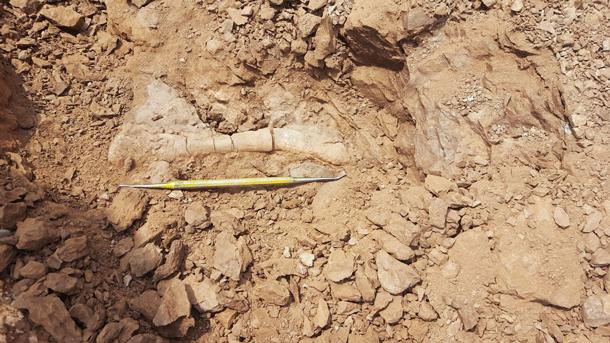Rare fossils could face trouble outside new Bears Ears National Monument boundaries
This is part of a phytosaur fossil unearthed by an excavation team in a now-unprotected area of Bears Ears National Monument.
The Trump administration's move to reduce the size of Bears Ears National Monument by 85 percent jeopardizes future research and excavation in one of the densest fossil troves in the world, according to scientists who work in the region.
More than 200 million years ago, giant reptiles wandered in Bears Ears, leaving a vast cache of recently discovered Triassic-era, fossilized bones, says paleontologist Rob Gay. He and his team have been exploring the Chinle Formation in Bears Ears National Monument.
“Bears Ears dates from the dawn of the age of dinosaurs, and we found all sorts of amazing fossils — plant-eating crocodile teeth; footprints, which indicate that armored, herbivorous crocodiles walked the landscape; and then, most recently, we came across a huge deposit of fossilized bones from animals called phytosaurs. These are 15- to 20-foot-long crocodile mimics with blowholes,” Gay explains. “It seems to be a very rare animal, and all of a sudden, we've got the world's largest treasure trove of this animal."
The site is enormous — about 63 meters long, which makes it the largest Triassic bone bed in the state of Utah and possibly one of the densest in the country, if not the world, Gay adds.
All federal land has some basic protection for vertebrate fossils. But additional protections are in place within national monuments, not just for vertebrate fossils, but also for invertebrate and plant fossils, Gay explains. “Without a monument, anyone can come and collect plant fossils and shells, legally. It’s not prohibited,” he says. “Whereas in a monument, that activity is restricted to permitted scientists.”
Bears Ears was also protected as part of the National Conservation Lands, which is a system of Bureau of Land Management areas mainly across the West encompassing national monuments, conservation areas and historic trails. Congress sets funding aside for scientific exploration of these lands. Now that the site is no longer in a protected area, it's not eligible for these funding sources.
As for the Trump administration’s plans for drilling, Gay doesn’t see much potential in the region for oil and gas. The area was extensively drilled in the 1920s and 1930s and came up with nothing, he says. There is coal within the boundaries of Bears Ears, but the seams are small and not likely to be commercially viable.
The most likely material to mine within Bears Ears is uranium. The uranium boom of the 1950s and 1960s fueled the development of roads into the area and, ironically, Gay adds, also fueled the development of scientific understanding of the fossils in the region. Expanding uranium development in the area now would severely threaten fossil resources, and "while that is a possibility, the fact that existing mines in the area are not producing uranium tells me that the commercial value of the uranium in the ground is probably not too high.”
Gay says he will continue to seek funding for his work and will continue exploration in the region. Outside of that, “the next steps are to figure out what the heck we actually have. What did we pull out of the rock? The fossils are currently undergoing preparation at the St. George Dinosaur Discovery Site in St. George, Utah, where they are being removed from their rocky cradles. I'm really excited to see what all comes out of there.”
This article is based on an interview that aired on PRI’s Living on Earth with Steve Curwood.
